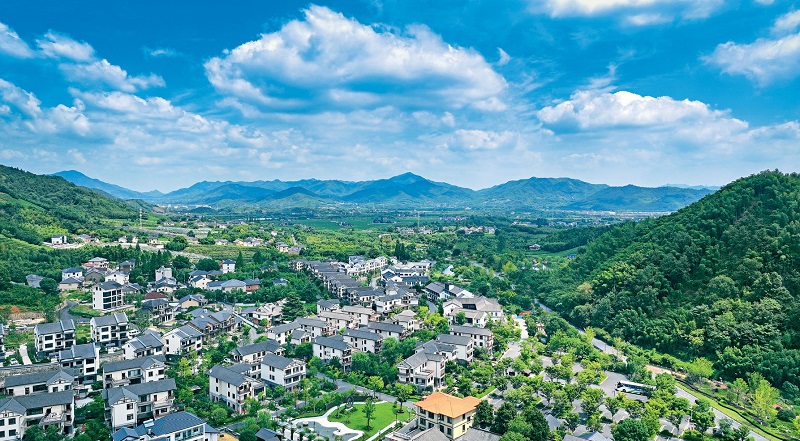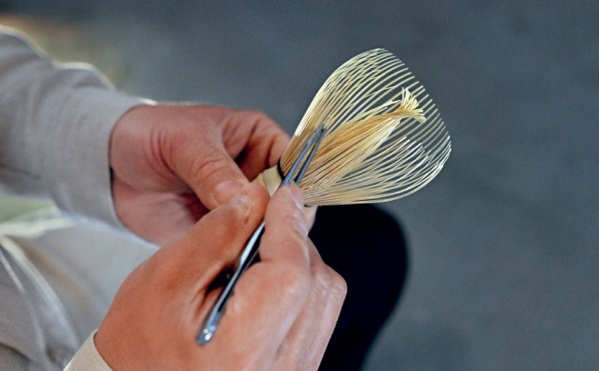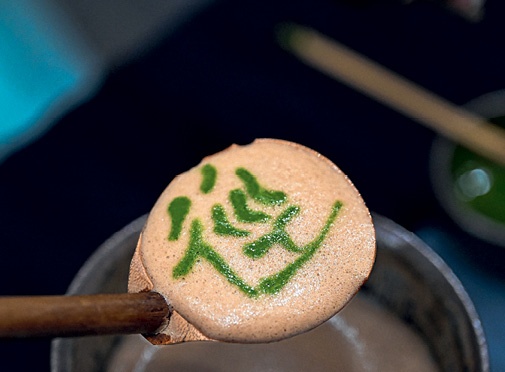Strolling through a village named Jingshan located in Hangzhou City, east China’s Zhejiang Province, one will notice the image of a “little tea farmer” wearing a bamboo hat and carrying a tea basket in many places. It is the village’s culture and tourism ambassador “Jing Lingzi,” who got his name from the Chinese tea sage Lu Yu (733-804)’s homophonous nickname, and symbolizes the inheritance and protection of local ancient tea culture.
Tea cultivation in Jingshan dates back to the Tang Dynasty (618-907), with a history of more than 1,200 years. In April this year, with its distinctive model of “tea and bamboo industry + leisure and cultural tourism,” the village was selected as one of the first pilot sites for implementing the national initiative on zero-carbon villages and towns. This marked the beginning of its exploration in transforming ecological value into economic value through zero-carbon practices.

A panoramic view of Jingshan Village.
A Green Transformation
“This is our village’s ‘green asset! ’” Yu Ronghua, Party secretary of Jingshan Village and director of Jingshan Villagers’ Committee, said, pointing to the boundless greenery spreading out before him. The village’s bamboo forests store over 10,000 tons of carbon, boast rich biodiversity resources, and have an air negative ion concentration as high as 30,000 per cubic centimeter.
However, over 20 years ago, the village displayed a very different sight – one of struggling with the negative effects of mining. Back then, the village’s only quarry, covering an area of just over 0.13 hectares, damaged more than seven hectares of surrounding mountains. Even worse, the ecological destruction and safety hazards that ensued became pressing problems for villagers.
A turning point came in the summer of 2005. On August 15 that year, Xi Jinping, then Party Secretary of Zhejiang Province, first put forward the development concept “Lucid waters and lush mountains are invaluable assets,” which pointed out a new direction for the development of Jingshan. As a result, the village decided to shut down the quarry and fully turn to ecological restoration. Today, those once-barren pits and slopes have been transformed into a vast wetland where large bamboo forests and tea gardens are flourishing side by side. The restored ecosystem has not only bring a beautiful landscape but also a massive “carbon-absorbing sponge,” where the annual vegetation carbon absorption exceeds 12,000 tons and net carbon emissions reach 7,938.79 tons.
Walking along the mountain path leading to the millennia-old Jingshan Temple, the air is filled with the fragrance of tea plants. During harvest season, tea pickers can be seen scattered across the tea gardens. Animals under China’s first-level state protection, such as the black muntjac and Elliot’s pheasant, along with more than 580 species of rare wild flora and fauna, inhabit these carefully protected remote mountains. The return of these rare species stands as a powerful testament to the continuous improvement of the local ecological environment.

Chen Jinxin makes a tea whisk, the main tool used in matcha preparation for the “Jingshan Tea Banquet,” a national-level intangible cultural heritage.
Lighting up the Road to Prosperity
“Scan the QR code on the tea package, and you’ll see a carbon footprint assessment report,” explained Yu Ronghua as he introduced China’s first-ever “carbon label” for Jingshan tea. The report clearly lists the lifecycle carbon emissions of each batch of Jingshan tea and a method for tracing information about them.
Stepping into the “Tea Fairy” Common Prosperity Workshop, two livestream anchors were busy in front of the camera, introducing the history of Jingshan tea and its profound culture, while recommending a range of tea products to potential buyers on the other side of the screen.
“We want to integrate Jingshan’s most distinctive tea into modern life,” said Chen Yueyan, a native who is now product manager at the village’s tourist reception center. Having grown up in the area, she viewed the surroundings, ancient temples, old paths, and tea as an inseparable part of her life. According to her, almost every household in Jingshan is connected to tea. The village is home to six large-scale tea enterprises, with an annual tea output of more than 30,000 kilograms and an output value of over RMB 60 million.
Chen is skilled in tea-whisking, a skill which flourished during the Song Dynasty (960-1279). The technique she demonstrates is displayed in A Dream of Splendor, a Chinese period drama, where tea powder is placed into a dark-glazed bowl and whisked rapidly with a specially made bamboo whisk until a fine foam rises to the surface and lingers for a long time. The revived ancient method of whisking tea from the Southern Song Dynasty (1127-1279), together with recreating the tea banquet rituals of the Song Dynasty, and creating immersive tea ceremony experiences have already become signature tourist attractions of Jingshan.
In the Zen Tea New Village, Chen Jinxin, an inheritor of the traditional craft of making tea whisks, is devoted to this ancient craft. His family has been engaged in bamboo weaving for generations. Though a tea whisk may look simple, it embodies more than a decade of dedication from both father and son. At work, Chen bends over a wooden table, carefully separating bent bamboo strips and twisting the inner strands into flower-like shapes. To him, every tea whisk is not only a tea utensil but a piece of art. “This preserved ancient skill not only represents an intangible cultural heritage but also provides jobs for more than 30 villagers.” Today, the Chen family sell nearly 100,000 tea whisks all over Asia, Europe, the Americas, and Southeast Asia every year.

The tea-whisking technique of Jingshan was highly popular during the Song Dynasty (960-1279).
A Digitally Empowered “Village of the Future”
The vitality of Jingshan Village lies also in its ability to attract more and more young people to return home and start local businesses. One of them is Ma Kuan, a second-generation tea farmer who graduated from Newcastle University in Singapore. In 2019, after realizing the potential of his hometown’s tea industry, he returned home for the integration of tea culture with tourism. After taking over the “Wufengshan” brand founded by his father, he delved deeply into Jingshan’s Zen tea culture and created a comprehensive culture and tourism project that integrates dining, accommodations, sightseeing, entertainment, shopping, and traveling.
Meanwhile, 12 idle farmhouses in the village have been transformed into themed spaces such as workshops for making tea whisks and desserts made of tea. Notably, all these spaces are connected to an energy consumption monitoring system, embedding the concept of carbon reduction into the daily life of village residence. “I can redeem daily necessities again with my carbon credits. It’s practical and eco-friendly!” said villager Wang Junxia at the tourist reception center, as she checked real-time data of the village’s electricity consumption and carbon sinks displayed on a large “digital cockpit” screen.
The bus stop in Jingshan is equipped with solar photovoltaics which continuously powers its LED screens, cameras, lightboxes, and phone-charging ports. Along the Hongxi Greenway, IoT-enabled solar streetlights, photovoltaic benches, and solar ground lights can be seen everywhere. Data from all these low-carbon scenarios is fed into the “digital cockpit,” contributing to an annual carbon reduction of over 208 kilograms.
“Our village is becoming more and more beautiful, the air is getting fresher, and the number of visitors is increasing, with many eager to experience the joy of being a ‘tea farmer for a day’!” Speaking of the future, the villagers’ committee director Yu is full of confidence. “We firmly believe time will reveal the truth that lucid waters and lush mountains are indeed invaluable assets, and a zero-carbon village is the village of the future.”